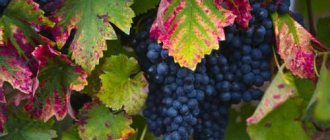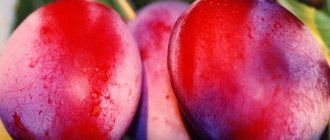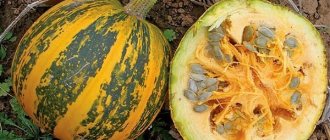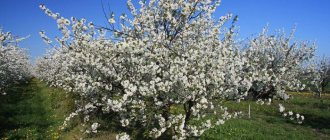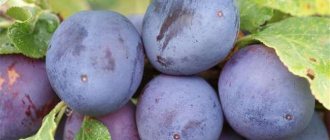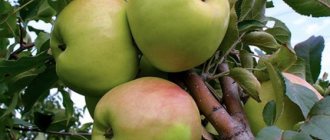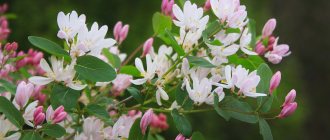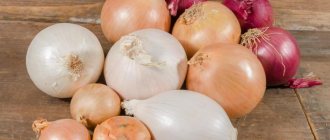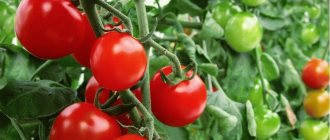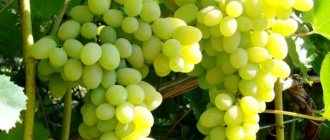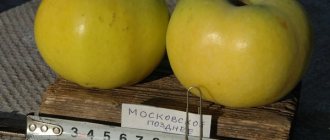Loading…
Loading…
Conditions for gardening in the Leningrad region cannot be called ideal or even good. Neither the climate of the region nor the composition of the rather poor soils are conducive to the cultivation of fruit trees. The thickness of the fertile layer in some areas does not exceed 20–30 cm; gardens have to be laid out on peat bogs, sand and loam.
Harvesting in the conditions of the North-Western region is very difficult, so the varieties of apple trees offered by breeders for the Leningrad region are distinguished by high frost resistance, resistance to diseases and pests, and the fruits on such trees should ripen as early as possible.
Apple Tree Chosen
The ripening of the fruits of the Chosen apple tree occurs in the last ten days of August or the first days of September.
The variety was bred on the basis of Antonovka and the Bellefleur-Chinese variety by scientists from Moscow State University.
M. V. Lomonosov. At the end of the last century, the apple tree was zoned in the Lower Volga and in the North-West of the country, where high frost resistance of trees, good resistance to scab and relatively early fruiting are extremely important. A medium-sized apple tree with a wide, sparse crown is distinguished by strong attachment of skeletal branches. The shoots on the trees are powerful, short, with noticeable pile and large leathery leaves, also pubescent on the back side. The ovaries are mainly formed on the ringlets, and the mass ripening of fruits often begins in the sixth year after planting in the ground. The rather large fruits of the Izbrannitsa apple tree have a flattened-rounded shape with barely noticeable ribs, smooth yellow skin and red shading over almost the entire surface. The fruits retain their sweet and sour harmonious taste and juiciness until November.
Apple tree Melba
Melba is one of the oldest foreign varieties of apple trees, appearing in Russian gardens more than a hundred years ago. The Melba apple tree was first obtained in Ottawa in 1898, and since then the fragrant, juicy fruits have been loved in many regions of the world, including Russia, where the variety is also zoned in the Leningrad region. Active fruiting of apple trees with a rounded crown begins 4–5 years after planting. Most of the ovary is formed and matures on the ringlets, and the medium-length and thick shoots are pubescent and covered with oval, slightly curved leaves of a fairly light shade.
Fruiting of young Melba apple trees occurs annually, but with age there may be breaks, although the overall yield of the variety remains high.
Apples ripen towards the end of August, are medium or large in size and have a round or slightly conical shape. The very thin, light-colored skin of ripe fruits is decorated with an intense striped or blurred blush. Among all varieties of apple trees for the Leningrad region, Melba is distinguished by its snow-white, delicate pulp with a bright aroma and excellent taste. Despite their apparent vulnerability, apples are well transported and can be stored cool until mid-winter.
The best varieties for the Leningrad region
Not all varieties of apple trees can demonstrate their qualities in a cool and humid climate. Due to the short summer in the Leningrad region, there is a danger that winter apples will not have time to ripen on the tree. Therefore, give preference to summer and autumn apple trees, adding to them zoned varieties of late ripening.
If you plant summer, autumn and winter varieties in the garden, the likelihood of pollination of apple trees will be much higher.
Summer (early) ripening apple trees
Apples of summer varieties ripen in July - August. They are sweeter than the fruits of later varieties, but have loose pulp. They can be eaten immediately, but these apples cannot be stored for a long time. The fruits retain their marketable appearance for no more than a month after harvest.
Apples grown in the Leningrad region have a higher vitamin C content compared to fruits grown in the southern regions.
Apple tree Aelita
In the northwestern region, Aelita apple trees, grown as a result of crossing the Brown Striped and Welsey, were zoned in 1999. And for the first time the variety was obtained at the All-Russia Research Institute. I.V. Michurina by the famous breeder, author of many popular varieties of fruit trees S.I. Isaev.
Despite their tall growth, trees with a wide pyramidal crown have pronounced winter hardiness, are not affected by scab and can withstand abundant harvests even in the conditions of the Leningrad region. Flowering and ovary formation occur on perennial straight shoots covered with elongated dark green leaves with a prominent pointed cone.
The round-conical fruits of the Aelita apple tree, weighing about 120 grams, have a regular shape and a yellow-green main color, on which a solid or striped red blush stands out well.
Apples have yellowish, pleasant-tasting, fine-grained pulp, the best qualities of which are revealed in mid-September; the fruits are removed from the branches two weeks earlier and stored until the onset of the new year.
Features of the climate in the region
It cannot be said that the Leningrad region is suitable for growing various crops that grow in garden plots. Here, climatic conditions are constantly changing, regardless of the time of year. In the region, even in summer, temperatures fluctuate greatly.
In addition, it is often quite difficult to work in the garden, because... There is frequent rainfall, high humidity levels, and the soil is infertile. In some areas, the maximum thickness of the fertile layer is 20-30 cm. This means that you will need to import more land, use fertilizers, and also improve quality characteristics, etc. Therefore, it is not surprising that the owner of a summer cottage, who puts in his labor, wants to receive as much as possible more yield from growing crops. This also applies to fruit trees. Therefore, it is worth choosing apple varieties for the Leningrad region, which were specially bred by breeders for this region.
It may be interesting How to rejuvenate an old apple tree in the fall: rules and pruning schemes How and when to replant an apple tree in the fall to another place Apple tree of the “Cinnamon Striped” variety - I recommend for planting The Leningrad region is located in the North-Western District, and in the State Register of Breeding Achievements it is listed as number two. The region is divided into two climatic zones:
- in the western and northwestern regions the climate is characterized by strong winds and frosty winters, while spring is late. Here the soil is infertile, and groundwater lies close to the surface of the earth, which is associated with numerous swamps;
- in the eastern and southern regions the climate is warmer, humid, with mild winters; snow begins to fall only in December. There are frequent thaws here, and summers are cool and rainy. The soil is of a soddy-podzolic type, and groundwater rises close to the ground.
In the Leningrad region, the temperature in winter is 10-12℃ with a minus sign, although there are also frosts. In summer, the thermometer rises to +18-20℃.
Attention!
In regions close to the Baltic and southern regions, hot days are not uncommon.
Due to such conditions, it is difficult to grow apple trees, because... The growing season for them is short. But, despite this, gardeners learned to reap a rich harvest. They are convinced that it is enough to properly care for the crop and choose the right variety. For example, for areas with a humid climate, early ripening varieties that are resistant to fungal diseases are suitable.
Apple tree Auxis
The variety, bred in Lithuania from crossing the McIntosh variety and the red Grafenstein variety, came to the Leningrad region and the outskirts of Kaliningrad in the last century and has established itself as winter-hardy and unpretentious.
The Auxis apple tree variety begins to bear fruit five years after the seedling is planted in the ground. By this time, a medium-sized tree with a round crown is formed, capable of producing significant and regular harvests.
Flowering starts in the second half of May, and by the end of summer large, up to 140 grams in weight, apples of regular shape ripen. In September, by the time they are removed from the branches, the apples are greenish or yellow in color with a carmine blush. And after 2–3 weeks the main color becomes yellow, the blush spreads over almost the entire fruit. The sweet and sour dessert fruits of the Auxis apple tree with yellow, dense pulp can be preserved until winter, and when refrigerated, the apples do not lose quality until March.
Climatic conditions
Whatever one may say, this region is by no means the best place for cultivating a prolific columnar or medium-sized apple tree. This tree, as a rule, is very sensitive to frost, and in the Leningrad region low temperatures are common. In addition, the poor composition of the soil will certainly affect the intensity of fruiting.
Read also: Unusual coniferous pseudo-hemlock: growing features
The fertile layer of soil is present, but in small quantities (sometimes its layer is no more than 20–30 cm, so seedlings of fruit trees, including apple trees, have to be rooted on peat, loamy and sandy soils).
Description and photo of the Welsey apple tree
The American apple variety Welsey, bred in 1860, is approved for a number of regions of the European part of Russia, including the Leningrad region. Therefore, many gardeners know Welsey apple trees by description and photo, and also have their own experience in growing medium-sized trees that winter well in harsh climates and are not susceptible to scab. Young apple trees produce their first harvest at the age of 4–5 years.
Thanks to these qualities of the variety based on Wellsie, today more than three dozen new varieties of apple trees have been bred.
The variety can be called one of the leaders in yield, since an apple tree with a rounded crown can produce more than 250 kg of fruit per season. True, branches growing at an acute angle can withstand such a load only if there are good supports, otherwise breaking off large skeletal branches cannot be avoided. The opening of the often folded or curved small leaves is preceded by a mass appearance of pale pinkish or lilac flowers.
Apples of the winter Welsie variety are medium in size, flattened and covered with smooth skin of a light green or yellowish basic color. The fruits of the Welsey apple tree, according to the photo and description, have a rich, dark red, solid or blurry-striped blush and white or greenish flesh. The harvest takes place towards the end of September, and it is impossible to delay harvesting the fruits; literally within a week the apples begin to crumble. In favorable warm years, ripe fruits immediately after picking have a sweet and sour taste, but if the season was rainy, the consumer properties are reduced. By monitoring the air humidity in the storage, you can preserve Wellsie apples, which quickly lose their juiciness, until the end of winter.
Best varieties for the region
This fruit tree is a winter variety. Among its key features it is worth highlighting the following points:
- resistance to low temperatures;
- stable yield;
- average fruit ripening times;
- compactness.
The fruits have a red skin with a slight blush. Moreover, their weight is about 200 g. The plant begins to bear fruit when it reaches two or three years of age. As a rule, gardeners harvest in September or October.
Those looking for the best varieties of apple trees for the Leningrad region should pay attention to a variety called Auxis. The tree is considered medium-sized, but its crown is round and quite lush. The key advantage of this fruit tree is its resistance to low temperatures. But that's not all. Ripe apple fruits can be stored for a long time in refrigerators or cellars. At the same time, the plant regularly bears fruit.
Winter varieties of apple trees are the best solution for a gardener who wants to harvest generous fruit harvests in a region unsuitable for this. Aelita is a tall tree that forms a pyramidal crown. It can be safely planted in the Leningrad region, since frosts and scab of this apple tree are not terrible. The weight of mature fruits is about 120 g. Approximately two weeks after harvesting, apples acquire a rich, sweet taste.
The climatic conditions characteristic of the Leningrad region are the optimal environment for cultivating the Druzhnoe variety apple tree on a personal plot. This fruit tree exhibits excellent resistance to frost, as well as various diseases. This plant has stable fruiting, that is, you can harvest a full harvest every year. The average weight of one fruit will be 170 g. Sweet and sour fruits with juicy pulp will appeal to many lovers of this storehouse of vitamins.
You can also plant an apple tree variety called Zvezdochka in the northern region of the country. Approximately 6–7 years after the seedling takes root, it begins to actively bear fruit. Harsh winters, scab - the plant will certainly cope with such external factors, since it bears fruit even in such conditions. Shaping a tree does not require much effort from the gardener.
Chosen One
The main advantage of this plant is its large fruits, which weigh about 280 g. This variety of apple tree requires a lot of space around the seedling, since its crown is spreading. Interestingly, the fruits finally ripen with the onset of autumn, but they are not stored for long - literally until November.
Remember that this variety is immune to scab, but as for frost, this is not the most favorable factor for the growth of an apple tree.
For the Leningrad region and other northern regions of the country, this variety was once a curiosity. However, such an apple tree has been grown in Russia for more than 100 years. It is valued by domestic gardeners for its generous and stable yields, especially when the tree is just entering the fruiting phase.
The fruits have white pulp, which has an excellent aroma and taste characteristics. For those who want to cultivate the Melba apple tree at home or for sale, this variety is a good choice, since even long-term transportation of the fruits will not spoil their presentation.
Renet Chernenko
This tree is considered hardy and resistant to frost, scab and other adverse external factors. It is often planted in the suburbs of St. Petersburg, since these climatic conditions do not reduce the intensity of fruiting of the apple tree. The fruit tree begins to actively bear fruit in the sixth or seventh year after planting.
Tellisaare
Apples of this variety ripen around the end of September. They are sweet and sour, and their skin has a golden yellow hue. One fruit weighs about 80 g. The main advantage of this variety lies in the fact that the fruits are stored for quite a long time without losing their taste properties. You can save them until May.
A good variety suitable for the suburbs of St. Petersburg is the Wellsie apple tree. This is an American variety that bears fruit very actively. It is resistant to frost and scab, and its fruits are aromatic and tasty. The tree enters the fruiting phase in the fourth or fifth year of life.
Apple tree variety Druzhnoe
The Druzhnoe apple tree variety, which is fast-growing and resistant to common diseases and frosts, is the result of the work of breeders from the local Leningrad station, who used the unpretentious Antonovka common and the Jonathan variety for crossing.
Already in the fourth year, in the second half of May, the apple tree with a dense crown blooms and at the end of September produces the first harvest, consisting of large fruits weighing up to 170 grams. The apples have a round-conical shape and yellow-green skin. The ribs are clearly visible on the surface of the fruit. The blush is reddish-red, mottled or banded. The apples are very dense, sweet and sour, retaining their juiciness and taste until the beginning of spring. This quality, together with high yield, gives additional value to this apple tree variety for the Leningrad region.
Apple tree Antey
The large-fruited winter apple variety Antey is an achievement of Belarusian scientists. The variety was obtained from pollination of the Belarusian raspberry with pollen of a hybrid apple tree from the Babushkino and Newtosh varieties. The variety with good winter hardiness and regular fruiting was highly appreciated by Belarusian gardeners, and also aroused serious interest in the North-West region. A compact tree with a transparent, easily pruned crown, up to 2.5 meters high, begins to form an ovary 2–3 years after planting and annually produces up to 50 kg of strong apples, which can be stored for up to 6–7 months.
The number of Antey fruits, as well as their quality, are almost not affected by weather conditions, which turns out to be an additional advantage in the northern regions of Russia.
The fruits, almost completely covered with a dark red or burgundy blush, weigh about 200 grams and have a regular round-conical shape. A waxy coating is clearly visible on apples, giving the fruit a bluish or purple tint. Apple picking, depending on the weather in a particular region, begins at the end of September or in the first weeks of October. You can try the ripe sweet and sour fruits of the Antey apple tree in December. The variety is stored until the middle of next spring.
general characteristics
Still, gardeners have to take local conditions into account. So as not to be upset later by failures and money spent. And start over again in 5-10 years. So pay attention:
- For winter hardiness;
- The ability to resist diseases. Especially fungal diseases. Especially scabby;
- Early frosts force you to pay attention to varieties that have time to ripen by then.
You will also take into account:
- Tree type: Height;
- Width;
- Dense or sparse crown;
- What does it look like - a pyramid, a ball or an oval;
- Plant Antonovka, and it will take up half the plot.
I noticed it myself! When you plant according to recommendations, it seems like you leave a lot of space between the seedlings. And when you grow up, you remember the kind words of your advisors.
- Apple Type: Size;
- Coloring;
- Even shades and patina.
- Sweetness;
- How long to wait for the first harvest: Maybe you don’t have the patience to wait 7-8 years.
- Isn’t it necessary to have a place on the market to sell them?
We will look at the specific best varieties of apple trees below.
It is interesting to read reviews from gardeners. And not dry academic assessments of specialists. After all, according to some experts, it is necessary to get rid of some ancient varieties. Antonovka, Korobovka, Grushovka Moskovskaya, White filling need to be changed. And they are in good demand. I also have Borovinka. New items attract attention. I would like to grow both Silver Hoof and Belarusian Raspberry. Yes and others. But mine is enough for me.
I have been renovating my garden for several years. But from the old ones I still leave White filling and Glory to the winners. Iyulskoe Chernenko, Antey, Krasa Sverdlovska complemented the assortment very well. The Baltic and Finnish varieties are interesting. I'll take a closer look. Nurseries offer. But we need expert advice. Who has had them for more than a year?
I have also been working on columnar apple trees on my site for several years. There are a lot of advertisements. The cost is decent. But so far they cannot replace our reliable ones - White filling, Zvezdochka, Streifling, Bogatyr. They look beautiful. And the taste is not very satisfying. Maybe I'm rushing to conclusions? But the columnar ones bear fruit earlier. A dozen apples are just for variety.
Two varieties from the Ural collection delighted me. Its winter hardiness and productivity. Beauty of Sverdlovsk and Silver Hoof. I advise others to plant it at home. You will not regret.
Apple Tree Asterisk
Another winter apple variety for the Leningrad region was obtained at the All-Russian Research Institute named after. I.V. Michurina. Star is the result of crossing Anise and Lithuanian Pepinka. The variety begins to bear fruit six years after grafting, and the apples ripen annually and the harvests are quite large. The culture is resistant to scab and tolerates winters well in the Leningrad region. Mature, vigorous trees with a spreading or slightly drooping crown lend themselves well to shaping.
Zvezdochka apple trees respond positively to pruning, responding with larger fruits and laying a mass of flower buds on the middle and outer parts of the crown.
Winter ripening apples remain fresh and do not lose their consumer qualities until the end of February. With abundant fruiting of the Zvezdochka apple tree, the fruits are medium-sized, evenly flattened in shape with smooth green skin. By the end of the growing season, the apples are thickly covered with a dark carmine blurred blush. And their juicy sweet and sour pulp, usually greenish, can have a pink tint under the skin.
How to choose an apple tree for the northern regions
When choosing apple trees for planting, pay attention to characteristics such as:
- tree height;
- precociousness;
- winter hardiness;
- disease resistance;
- ripening time;
- taste qualities of fruits;
- frequency of fruiting.
Tall apple trees can reach a height of 15 meters. But as a rule, the tree grows 5–7 meters, and the roots go three and a half meters into the ground. Vigorous apple trees do not tolerate stagnant water on heavy soils; they are adversely affected by high groundwater levels. Under waterlogged conditions, the top begins to dry out and the tree dies.
Medium-sized apple trees (semi-dwarfs) do not grow higher than 3.5 meters, low-growing ones (dwarfs) do not exceed three meters in height. The roots of these trees are located close to the surface of the earth. The lumpy root system of “dwarfs” and “semi-dwarfs” is best suited for planting in the Leningrad region.
Low-growing apple trees are better suited than others for growing in the Leningrad region
When choosing a variety, follow the following recommendations:
Read also: The main reasons for curling leaves on an apple tree
The highest resistance to scab was observed in triploid varieties of apple trees (with a triple set of chromosomes). They are distinguished by early fruiting, early fruiting, and produce large apples with a high content of vitamin C. The disadvantage of these varieties is defective pollen, which reduces the percentage of fruit set.
Apple tree Renet Chernenko
The apple tree variety Renet Chernenko, the result of free pollination of the pepin Renet, is zoned in certain regions of the North-Western region, including the suburbs of St. Petersburg. Apple trees are vigorous, hardy, tolerate severe frosts well and are resistant to scab. For modern varieties, fruiting begins relatively late - after 6–7 years after planting in the ground, while the tree is capable of producing from 60 to 170 kg of late-winter ripening apples.
The matte, medium-sized fruits of the Renet Chernenko apple tree have a regular flattened-rounded shape, are colored in greenish or yellow tones and, on the side facing the sun, are covered with a bright red blush in the form of stripes or densely spaced specks. The sweet and sour harmonious taste of the white dense pulp lasts almost until the end of spring.
Apple tree Tellisaare
The high-yielding Tellisaare apple tree variety, which exhibits average winter hardiness and is resistant to scab, was obtained by Estonian amateur breeders, and today it is recommended for cultivation in the Leningrad region.
Apple trees of this variety have a dense, rounded crown that can withstand solid yields of small, up to 100 grams in weight, flattened or rounded fruits with a noticeable bevel to one side. The first ovary appears 4–5 years after planting. In years of abundant fruiting, the fruits sometimes become smaller, or the next year's yield decreases. Harvested in September, the firm apples have buttery greenish skin with a faint reddish-brown blush.
By October, when the Tellisaare apple fruits are ready to eat, the light green pulp becomes juicy, aromatic and has a good sweet and sour taste. The harvests of this variety are of high quality; apples are easy to transport and store until mid-February.

